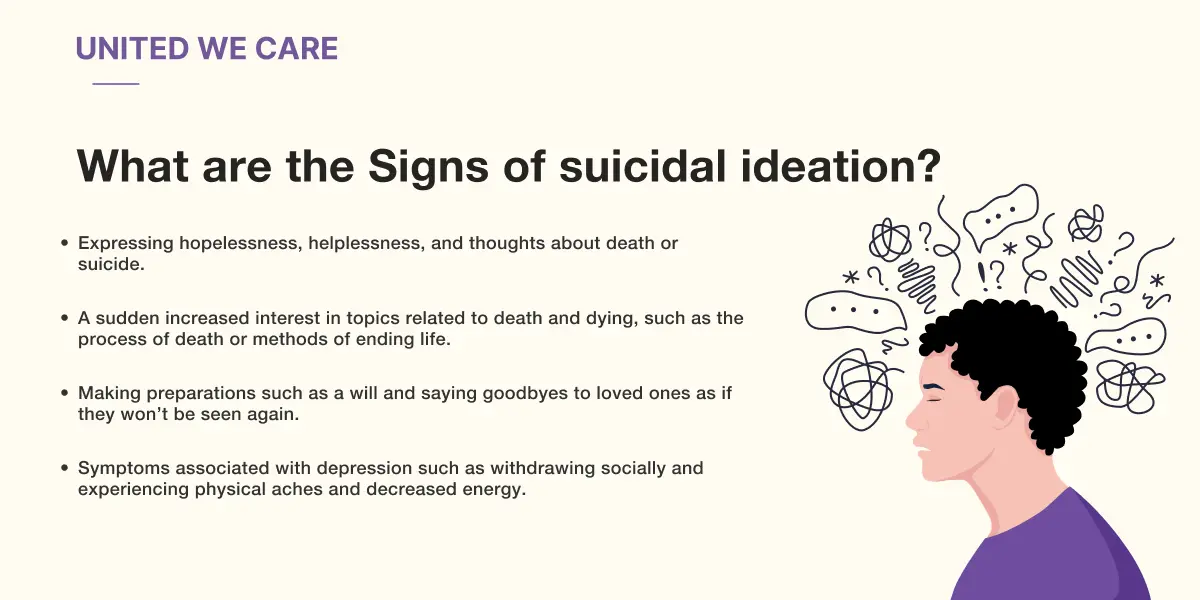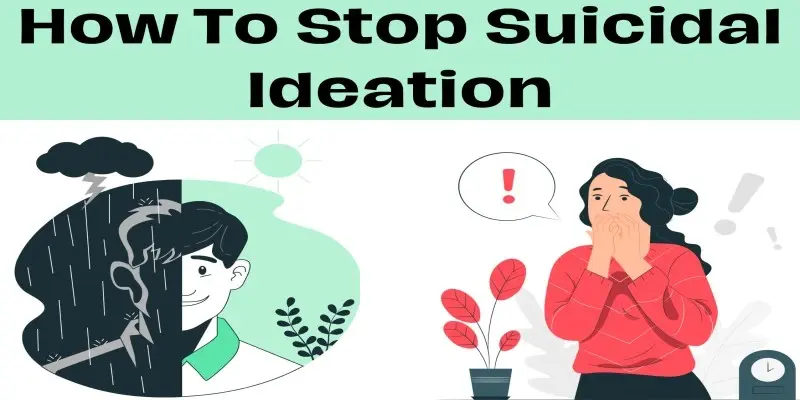Introduction
Our society expects us to look, live, and be successful in certain ways that are not realistic for everyone. As humans wanting to fit in and be accepted, we feel pressured to conform to these ideals, which can make us feel overwhelmed and like we’re not enough. On top of this, social media amplifies these idealized versions of life, which distorts our sense of reality. However, our reality is far from ideal. We’re in the middle of multiple wars, and social inequality and economic uncertainty are higher than ever before. All these factors combined are increasingly deteriorating our mental health. A deep-rooted cultural stigma around mental health discourages us from seeking the support we need, which in close to 10% of cases may lead to suicidal ideation.[1]
In this article, we’ll go into the depths of what suicidal ideation is, who’s at risk, symptoms to watch out for, and how to cope with and manage this behavior.
What is suicidal ideation?
American Psychological Association defines suicide ideation as thoughts about or preoccupation with wanting to end one’s life. This behavior tends to fluctuate in intensity, frequency, and specifications. It is important to note that most cases of suicidal ideation do not progress into a suicide attempt.[2]
Common risk factors for suicidal Ideation
- A history of mental health disorders, such as depression, anxiety, personality disorders, and schizophrenia, may increase your risk of suicidal ideation by over 20%. [3]
- Experiencing physical, mental, or sexual abuse, especially during childhood.
- Suffering from a chronic debilitating illness such as cancer. [4]
- Major life stressors such as financial crises [5] or the loss of a loved one. [6]
- A prior suicide attempt.
- Being a younger, unmarried, and less educated female. [1]
- Single, lonely, elderly men aged over 65. [7]
Signs of suicidal ideation

- Expressing hopelessness, helplessness, and thoughts about death or suicide.
- A sudden increased interest in topics related to death and dying, such as the process of death or methods of ending life.
- Making preparations such as a will and saying goodbyes to loved ones as if they won’t be seen again.
- Symptoms associated with depression such as withdrawing socially and experiencing physical aches and decreased energy.
What is passive suicidal ideation?
There are different stages to suicidal ideation, ranging from vague thoughts and no actual intention to follow through with the act to the last and most serious stage of completed suicide.
Suicidal ideation may initially present itself as fleeting thoughts about not wanting to exist, such as falling asleep and never waking up, with no desire to act on these thoughts.
When these thoughts become more persistent, they can lead to passive suicidal ideation. This means that the individual’s desire to escape distress presents itself as a desire to end life. In passive suicidal ideation, the individual doesn’t have a plan to go through with the actual act.
Further progression can lead to active suicidal ideation, wherein the individual may start thinking about how they might end their life. Following this, they may also start actively planning it, such as gathering the means, setting a date, etc.
It is crucial to seek professional help at any and every stage of suicidal ideation. However, the transition from passive to active ideation poses a serious threat. How long an individual takes to transition from the former stage to the latter varies based on each individual’s psychological, environmental, and situational factors.
Emergency and medical support may be required post this transition, i.e., if the individual expresses their intent and goodbyes, engages in an indicative behavior, or commits the act but survives.
What is a suicidal ideation scale?
If someone you know is ideating suicide, an assessment using a suicide ideation scale can help determine the intensity and nature of their suicidal thoughts. Professionals administer this tool, and it is important in assessing the risk a person is at, determining which strategies should be used for intervention, and planning the right course of treatment and support for them.
The most commonly used scales are:
- Beck Scale for Suicidal Ideation (BSSI): This self-report inventory will assess the severity of their suicidal ideation by exploring their desire to die, the frequency with which they have these suicidal thoughts, and whether they’ve made plans for suicide.
- Columbia-Suicide Severity Rating Scale (C-SSRS): Along with evaluating whether they have made any preparations to end their life, this scale will also take into consideration their past attempts, if any.
- Scale for Suicide Ideation (SSI): This scale focuses on understanding their attitudes toward life or death if they have any specific plans for suicide, and if they engage in passive suicidal ideation.[8]
If they score higher on these scales, they will generally have a more severe tendency to suicidal ideation.
How do you stop suicidal ideation?
Depending on which stage of suicide ideation a person is in, a combination of immediate and long-term strategies, along with professional help and medication, may be used to stop the ideation.
Suppose someone you know is thinking of or indicating ending their life. In that case, the first immediate step you can take is to create a safe environment for them, physically stay present with them, and encourage them to acknowledge their feelings. Practicing deep breathing and grounding techniques can help de-escalate the situation.
Once they’re out of the immediate threat, you can contact a mental health professional and encourage them to seek help. The cause of suicidal ideation is an underlying mental health condition in most cases. Hence, psychotherapy, such as cognitive behavioral therapy (CBT), is effective in addressing these issues.[9]
A comprehensive assessment, including the use of a suicide ideation scale, can help create the right treatment plan for them. Their healthcare provider may recommend healthy lifestyle changes such as a balanced diet, exercise, and good sleep hygiene. A doctor may also prescribe them medications such as antidepressants or mood stabilizers to manage the symptoms of their underlying mental health disorder.
Opening up to friends and family and sharing experiences and strategies in a support group can also help.
Conclusion
Suicidal ideation is a complex behavior with varying levels of intensity. Mental health disorders are the leading cause of suicidal ideation. If you know someone who is thinking or planning to end their life, it is important to encourage them to seek professional help at every stage. This behavior becomes more threatening if they progress from passive to active ideation. A combination of immediate de-escalation techniques, psychotherapy, healthy changes in lifestyle and coping mechanisms, and medication can help them manage this situation. If you or someone you know is ideating suicide, book a session to seek immediate help from one of our mental health experts at United We Care.
References:
[1] M. K. Nock et al., “Cross-national prevalence and risk factors for suicidal ideation, plans and attempts,” The British Journal of Psychiatry, vol. 192, no. 2, pp. 98–105, 2008. [Online]. Available: https://www.cambridge.org/core/journals/the-british-journal-of-psychiatry/article/crossnational-prevalence-and-risk-factors-for-suicidal-ideation-plans-and-attempts/BDD6458A563389FFE7E5226B7533BE98. Accessed: Nov. 21, 2023.
[2] American Psychological Association, “Suicidal Ideation,” in APA Dictionary of Psychology. [Online]. Available: https://dictionary.apa.org/suicidal-ideation. Accessed: Nov. 21, 2023.
[3] J.-I. Lee et al., “Prevalence of Suicidal Ideation and Associated Risk Factors in the General Population,” Journal of the Formosan Medical Association, vol. 109, no. 2, pp. 138-147, 2010. [Online]. Available: https://doi.org/10.1016/S0929-6646(10)60034-4. Accessed: Nov. 21, 2023.
[4] E. Kolva, L. Hoffecker, and E. Cox-Martin, “Suicidal ideation in patients with cancer: A systematic review of prevalence, risk factors, intervention and assessment,” Palliative & Supportive Care, vol. 18, no. 2, pp. 206–219, 2020. [Online]. Available: https://www.cambridge.org/core/journals/palliative-and-supportive-care/article/abs/suicidal-ideation-in-patients-with-cancer-a-systematic-review-of-prevalence-risk-factors-intervention-and-assessment/B273DB9A3143027C93AA9A4C351ABE70 Accessed: Nov. 21, 2023.
[5] A. Virgolino et al., “Lost in transition: a systematic review of the association between unemployment and mental health,” Journal of Mental Health, vol. 31, no. 3, pp. 432-444, 2022. [Online]. Available: https://doi.org/10.1080/09638237.2021.2022615. Accessed: Nov. 21, 2023.
[6] R. T. Liu and I. Miller, “Life events and suicidal ideation and behavior: A systematic review,” Clinical Psychology Review, vol. 34, no. 3, pp. 181-192, 2014. [Online]. Available: https://doi.org/10.1016/j.cpr.2014.01.006. Accessed: Nov. 21, 2023.
[7] M. Lutzman, E. Sommerfeld, and S. Ben-David, “Loneliness and social integration as mediators between physical pain and suicidal ideation among elderly men,” International Psychogeriatrics, vol. 33, no. 5, pp. 453–459, 2021. [Online]. Available: https://www.cambridge.org/core/journals/international-psychogeriatrics/article/loneliness-and-social-integration-as-mediators-between-physical-pain-and-suicidal-ideation-among-elderly-men/4AA58994D6D8F8F907FB8E3FB3C131CC. Accessed: Nov. 21, 2023.
[8] A. T. Beck, M. Kovacs, and A. Weissman, “Assessment of suicidal intention: The Scale for Suicide Ideation,” Journal of Consulting and Clinical Psychology, vol. 47, no. 2, pp. 343–352, 1979. [Online]. Available: https://doi.org/10.1037/0022-006X.47.2.343. Accessed: Nov. 21, 2023.
[9] H. Wu et al., “The significance of cognitive-behavioral therapy on suicide: An umbrella review,” Journal of Affective Disorders, vol. 317, pp. 142-148, 2022. [Online]. Available: https://doi.org/10.1016/j.jad.2022.08.067. Accessed: Nov. 21, 2023.










